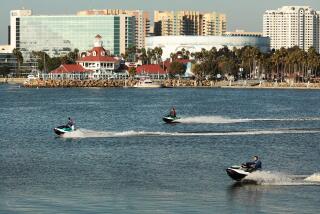Clinton Aggressively Courts Long Beach Vote
- Share via
With 58,600 jobs lost since 1991, in large part because of cuts in defense and aerospace spending, Long Beach’s struggles could have been one of President Clinton’s biggest election year liabilities.
Instead, the president’s aggressive courtship of the city appears to be turning the liability into an asset, as evidenced by a highly successful visit Thursday and a turnout of more than 2,000 mostly enthusiastic political supporters.
The visit left Mayor Beverly O’Neill and other city officials jubilant because Clinton reaffirmed his pledge to help the city recover from a series of economic shocks.
“I was frankly inspired by the determination, the energy, the vigor and vision of the plan that the people of Long Beach put together to bring this community back,” Clinton told the rally. “It’s going to work, and we’re going to help.”
O’Neill, who sat with Clinton, said the offer of assistance is heartfelt. “He likes the area,” O’Neill said. “He felt comfortable. You could tell that,” she said.
The visit also underscored Long Beach’s political importance this year as an area that can swing either Democratic or Republican. Democrats, with help from Clinton, feel that they have a chance to wrest three seats from Republicans in Congress and the Legislature.
One of the most interested participants at the rally was Betty Karnette, a former Democratic assemblywoman who is running for the seat in the state Senate being surrendered by Sen. Robert G. Beverly (R-Long Beach) because of term limits. Karnette, who is running against Assemblyman Phil Hawkins (R-Bellflower), lost her seat in the Assembly two years ago by a narrow margin.
This time, she believes that Clinton’s popularity could mean the difference in a close race. As for Long Beach, she and others said the city needs “all the help it can get.”
Long Beach has the dubious national distinction of being the city hardest hit by base closures and cutbacks in military spending.
Since 1991, the Navy has closed the Long Beach Naval Station and a Navy hospital, taking 16,500 Navy and 1,000 civilian jobs, with direct losses in wages of $400 million annually, the city said.
The Long Beach Naval Shipyard is also in the process of being dismantled, which means the loss of an additional 6,600 federal jobs and the elimination of 3,500 related jobs through subcontractors.
As for aerospace, the city estimates that 30,000 jobs were lost as a result of the downsizing at McDonnell Douglas. Those jobs meant the loss of $960 million annually in wages and benefits.
Add to that an estimated 1,000 jobs that disappeared in the 1992 riots, and the city estimates that the 58,600 jobs it has lost in recent years have left the area with $4 billion in economic losses.
As a countermeasure, Long Beach has developed major port and transportation packages that it hopes will revitalize the waterfront and restore some jobs. With an eye toward tourism, the city has sold $117 million in revenue anticipation bonds for what it hopes will be a world-class aquarium. It has also begun clearing land for the Queensway Bay waterfront project: stores and restaurants that may attract $700 million in public and private investment funds. The city hopes to have both projects ready to open by the summer of 1998.
The city is also leading the way on the $1.8-billion Alameda Corridor project to create a high-speed rail line from the ports of Long Beach and Los Angeles. Clinton has been a cheerleader on all those projects. The administration has helped clear the way by supplying seed money and loan guarantees.
The location of Clinton’s speech Thursday was filled with symbolism, from the location on a breakwater near the outer harbor to the audience filled with longshoremen, who will benefit most from the new port jobs. The Navy land will be deeded over to Long Beach for port development. On the morning of the speech, city officials participated with the Boeing Co. to break ground on a state-of-the-art Sea Launch rocket building facility that will be built just steps from where the president spoke.
O’Neill said it will take several years to determine how well the city does. “Changing the city from an economy based on military and aerospace to one with an economic generator based on tourism, international trade and industrial technology does not happen overnight.”
More to Read
Get the L.A. Times Politics newsletter
Deeply reported insights into legislation, politics and policy from Sacramento, Washington and beyond. In your inbox twice per week.
You may occasionally receive promotional content from the Los Angeles Times.










